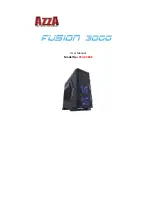
1. Before welding
The
NO
RED EYE
Welding Helmet comes ready for use. The only thing you need to do
before your welding is to adjust the position of the headband and select the correct
shade number for your application.
Check the front cover lens to make sure that they are clean, and that no dirt is cover
-
ing the four sensors on the front of filter cartridge. Also check the front/ inside cover lens
and the front lens retaining frame to make sure that they are secure.
Inspect all operating parts before use for signs of wear or damage. Any scratched
cracked, or pitted parts should be replaced immediately before using again to avoid
severe personal injury.
Check for light tightness before each use.
Select the shade number you require at the turn of a shade knob ( Seeing the Shade
Guide Table No.1 ). Finally, be sure that the shade number is the correct setting for your
application.
Adjust headband so that the helmet is seated as low as possible on the head and close
to your face. Adjust helmet’s angle when in the lowered position by turning the adjust
-
able limitation washer.
2. Dark shade number selection
The shade number can be set manually between 9-13 . Check the Shade Guide Table
to determine the proper shade number for your application. Select a shade number by
turning the shade knob until the arrow points to the required setting (See Shade Guide
Table No.1).
Welding
Process
Arc Current (Ampers)
0,5
2,5
10
20
40
80
125
175
225
275
350
450
1
5
15
30
60
100
150
200
250
300
400
500
SMAW
9
10
11
12
13
14
MIG (heavy)
10
11
12
13
14
MIG (light)
10
11
12
13
14
15
TIG, GTAW
9
10
11
12
13
14
MAG/CO
2
10
11
12
13
14
15
SAW
10
11
12
13
14
15
PAC
11
12
13
PAW
8
9
10
11
12
13
14
15
Note:
SMAW: Shielded metal arc welding
MIG (nehéz): MIG on heavy metals
MIG (könnyű): MIG on light alloys
TIG, GTAW: Gas tungsten arc welding
SAW: Shielded semi-automatic arc welding
PAC: Plasma arc cutting
PAW: Plasma arc welding
EN
10






































